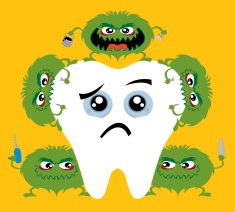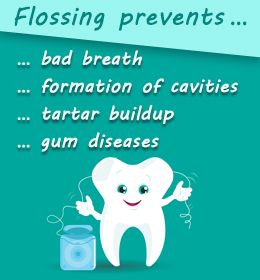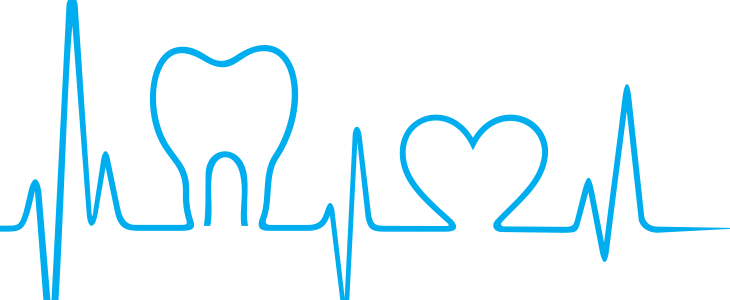Four Step Flossing Guide
You should floss your teeth at least once a day but not everyone knows the correct steps to do so. Use this four step guide to get the best results and help maintain a healthy smile.
- Break off approximately 18 inches of floss and wind most of it around one of your middle fingers. Wind the remaining floss around the same finger of the opposite hand. This finger will take up the floss as it becomes dirty. Hold the floss tightly between your thumbs and forefingers.
- Guide the floss between your teeth using a gentle rubbing motion. Never snap the floss into the gums.
- When the floss reaches the gum line, curve it into a C shape against one tooth. Gently slide it into the space between the gum and the tooth.
- Hold the floss tightly against the tooth. Gently rub the side of the tooth, moving the floss away from the gum with up and down motions. Repeat this method on the rest of your teeth. Don’t forget the back side of your last tooth. Once you’re finished, throw the floss away. A used piece of floss won’t be as effective and could leave bacteria behind in your mouth.
Talk to us today about what types of oral care products will be most effective for your oral health needs.
Take care of your oral health and it will take care of you
Taking good care of your mouth, teeth and gums is a worthy goal for more than the obvious reasons.
As well as helping to prevent bad breath, tooth decay and gum disease, a healthy mouth may also help you to ward off medical disorders whilst an unhealthy mouth, especially if you have gum disease, may increase your risk of serious health problems.
Your mouth serves as a helpful vantage point for detecting the early signs and symptoms of systemic disease — a disease that affects or pertains to your entire body, not just one of its parts. Systemic conditions such as AIDS or diabetes, for example, often first become apparent as mouth lesions or other oral problems. In fact, according to the Academy of General Dentistry, more than 90% of all systemic diseases produce oral signs and symptoms.
Although your saliva helps protect you against some invaders, it cannot always do the job. More than 500 species of bacteria thrive in your mouth at any given time. These bacteria constantly form dental plaque — a sticky, colourless film that can cling to your teeth and cause health problems. If you don’t brush and floss regularly to keep your teeth clean, this plaque can build up along your gumline, and create an environment for additional bacteria to accumulate in the space between your gums and your teeth. This gum infection is known as gingivitis. Left unchecked, gingivitis can lead to a more serious gum infection called periodontitis which could eventually lead to tooth loss.
Bacteria from your mouth normally don’t enter your bloodstream. However, invasive dental treatments — sometimes even just routine brushing and flossing if you have gum disease — can provide a port of entry for these microbes. Medications or treatments that reduce saliva flow and antibiotics that disrupt the normal balance of bacteria in your mouth can also compromise your mouth’s normal defenses and allowing these bacteria to enter your bloodstream.
If you have a healthy immune system, the presence of oral bacteria in your bloodstream should not cause any problems. However, if your immune system is weakened, for example, because of a disease or cancer treatment, oral bacteria in your bloodstream (also known as bacteremia) may cause you to develop an infection in another part of your body. Infective endocarditis, in which oral bacteria enter your bloodstream and stick to the lining of diseased heart valves, is an example of this phenomenon.
If you didn’t already have enough reasons to take good care of your mouth, teeth, and gums, the relationship between your oral health and your overall health provides even more. Practice good oral hygiene every day and make an investment in your overall health, not just for now, but for the future, too.
Contact us today and book an oral health review
Tooth Decay and how to prevent it
There are several things you can do to prevent tooth decay
Brush and floss daily– By brushing and flossing twice a day, you are helping to remove the build-up of plaque (the invisible, sticky film over your teeth) which contains the bacteria that attacks your tooth enamel and causes cavities. Brushing alone is not enough – you must floss between your teeth to remove the hidden plaque and bacteria, and this also helps to keep your gum line clean too. If your teeth bleed when you floss, ask your dentist for tips on improving your flossing technique.
Visit your every six months for a scale and polish appointment– Over time, the plaque on your teeth that can’t be removed by brushing or flossing alone hardens into tartar, which needs to be removed by your dentist with a thorough cleaning. Our general dentist uses ultrasonic instruments to tailor the cleaning to your comfort level and sensitivity, or if you have very sensitive teeth we can use hand instruments for effective plaque removal.
Monitor your sugar intake– High-sugar diets lead to all sorts of health problems, but they are particularly harsh on your teeth as the bacteria in your mouth utilises the sugar from foods and drinks to produce acids which attack your tooth enamel and cause decay and cavities. We know it is next to impossible to avoid all sugar, but, by reducing your intake of fizzy sugary soft drinks, cutting back on sweets and being aware of the hidden sugar content of the foods and drinks you consume, you can help to prevent decay.
Speak to your dentist about any medications you might be taking- Occasionally, certain medications can accelerate the decay process, so, although your diet might be healthy and low in sugar, you may still develop cavities. Medications such as high blood pressure treatment, antacids or antihistamines can lead to oral health complications. If you are concerned about the impact these could have on your teeth, talk to us about a comprehensive treatment plan for looking after your whole mouth.
Book online with us here
What is tooth decay?
| Tooth decay is caused by the loss of minerals like calcium and phosphate from your tooth surface (also referred to as “demineralisation”).
Demineralisation is a result of acids produced by the bacteria on tooth surfaces attacking your tooth enamel. Cavities are caused by prolonged demineralisation. An early sign of demineralisation may appear as a white spot on the tooth. At this stage, lost minerals may be replaced with the help of fluoride. If minerals continue to be lost, a hole (cavity) forms in the tooth and a filling is required to repair the damage. Tooth decay occurs on the chewing surfaces, the surfaces between the teeth and around fillings. When gums recede decay can also occur on the root surfaces of teeth. |

Tooth Decay Prevention
- Remove plaque thoroughly from all tooth surfaces by daily toothbrushing and flossing/interdental brushing.
- Use a toothpaste with appropriate level of fluoride, twice daily.
- Use a soft or medium toothbrush. Brush in a set pattern, making sure that you don’t miss any teeth. Ask our hygienist for a lesson on how this should be done.
- Use floss or interdental brushes to clean between the teeth, where cavities can often develop.
- Reduce your sugar intake – especially between meals
- If you suffer from a dry mouth, possibly due to medication, talk to us about appropriate care.
- Have regular dental check-ups to make sure that your dental hygiene is up to scratch.
For more information on tooth decay and how you can prevent it;
Contact us on
Phone: 01-5378045
Lo-Call: 1890223344
Email: hello@dentalhouse.ie


